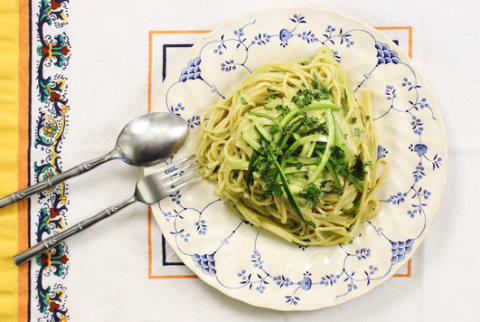Advertisement

It’s delicious, it’s nutritious, and it’s versatile. It’s…. pasta?
That’s right—though some fad diets may have threatened to cast a shadow on this Italian classic of late, research suggests we probably shouldn’t throw the pasta out with the bathwater. Meals starring spaghetti and its siblings are credited with providing a dose of fiber, lean plant-based protein, and vitamins and minerals. (And, uh, doesn’t hurt that they are irresistibly delicious.)
Of course, the devil is in the details. Twirling pasta onto our forks alongside nutrient-packed veggies, good fats like olive oil, and powerhouse proteins—as well as keeping portions in control (one serving is about the size of a baseball when cooked)—will ensure pasta keeps its healthy halo. But experts have long known that this Mediterranean style of eating is one of the world’s most saintly ways to eat and can help promote health and help prevent disease.
One analysis, whose findings were just presented at Experimental Biology, an expansive scientific conference, even showed that people who regularly consumed pasta as part of a Mediterranean-style diet were less likely to be overweight or obese or have a high body mass index (BMI).1
Here are 5 more science-backed reasons why this time-saving, tummy-satisfying dinnertime classic should be dubbed part of a super-nourishing weekly meal.
1. Fiber is our friend.
It’s an undisputed fact: most Americans do not hit their recommended intake of 25 to 38 grams of fiber every day. More research presented at Experimental Biology 2016 showed pasta eaters as a whole had significantly higher fiber intakes than non-pasta eaters.2 Including pasta in the diet—and better yet, using it as a canvas for adding crunchy, fibrous veggies and fiber-packed legumes—can help us tally toward that daily quota.
What’s more, according to the U.S. Food and Drug Administration, diets low in fat and rich in fiber-containing grain products, fruits and vegetables may reduce the risk of some types of cancer and heart disease.3
2. It’s best to be calculating about carbs.
Carbohydrates are the main source of energy in our food and help us function. Choosing complex carbs is the healthiest way to get your daily dose.
And did you know that pasta has a low glycemic index, even lower than oatmeal and quinoa? Whole wheat and enriched white pasta are good carbs because they break down more slowly in the body than many other refined grains, helping to keep blood sugar levels from abruptly rising and crashing, which can cause cravings and energy depletion.
Perhaps this is why the aforementioned study showed that adults who ate pasta regularly were less likely to be overweight than those who ate pasta less often.
It’s important to remember that not all refined grains are created equal. When in doubt, let this graphic be your guide!
3. You know what it’s made of.
Looking for a clean food? Pasta has simple ingredients such as durum wheat and water.
Pasta contains no added fat or sugar to boot, and enriched pasta has added vitamins, so you get a bonus of essential B vitamins and iron, which helps carry oxygen to the muscles and the brain.
4. It’s sustainable.
Variety is the spice of life, but in this case, it’s also better for the planet. As a plant-based food, pasta itself has a lower carbon footprint than other animal-based food groups like meat, ultimately reducing environmental impact and making it a more sustainable way to eat.
So go ahead and pile on the produce, marinara, and herbs. After all, the latest Dietary Guidelines reveal Americans are not eating enough nutrient-rich vegetables, a food group that pairs perfectly with pasta.
5. Pasta paves the way for (good, smart) proteins.
Health experts say the combination of carbs and protein gives a steadier supply of energy for hours after you’ve eaten, helpful in tackling everything from staying focused at work to doing high-intensity cardiovascular exercise.
Speaking of exercise, the same power pairing of protein and carbs can aid in muscle recovery after an intense workout. To achieve it in every bowl of pasta, add nuts to bring texture and crunch as well as a welcome protein boost, chop up lean organic chicken, or add responsibly-caught fish like wild salmon that contain healthy omega fatty acids, which can help protect your brain cells, upping your mood and overall brain function.
Get Cooking!
For a healthy, satisfying pasta dish that checks all the boxes, try this genius combo of pasta with zucchini “noodles” in a creamy avocado sauce. For more healthy and delicious pasta ideas, check out Passion For Pasta, and don’t forget to hashtag your creations #PassionForPasta!
Spaghetti with Zucchini & Avocado Sauce
Serves 6
Ingredients
- 1 box spaghetti
- 1 large leek, sliced and rinsed well
- 4 tablespoons extra-virgin olive oil
- 1½ cups vegetable broth
- 2 medium ripe avocados, peeled and pit removed
- 1 tablespoon lemon juice
- 1 large zucchini, skin only, julienned
- 1 tablespoon fresh parsley, chopped
- Salt and black pepper, to taste
Preparation
1. Sauté leek with 3 tablespoons oil over medium heat in a medium skillet for 3 minutes. Add broth, turn heat to high, and bring broth to a boil. Cook until reduced by half; remove from heat and let cool.
2. Meanwhile, bring a large pot of water to a boil; season with salt. Add the pasta and cook according to package directions.
3. To make the sauce, blend cooled broth, avocado, lemon juice, salt, and pepper in a food processor until smooth; set aside.
4. Sauté remaining 1 tablespoon olive oil and zucchini skins over medium heat for 1 minute in the same skillet used for the leek mixture.
5. Toss pasta with avocado mixture and zucchini in a large serving bow. Garnish with parsley.

These Peanut Butter Cup Protein Bites Make The Perfect On-The-Go Snack
Molly Knudsen, M.S., RDN











